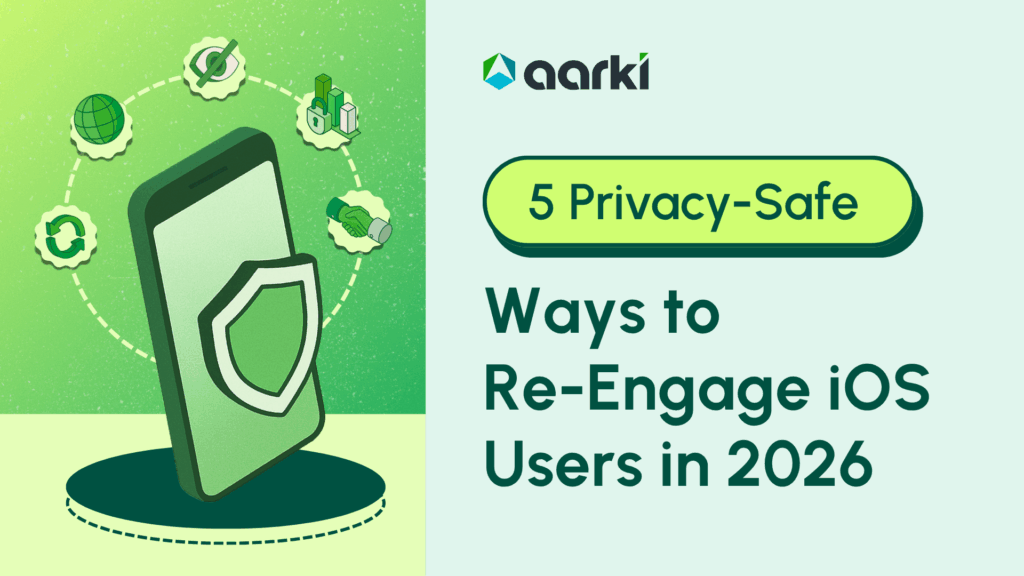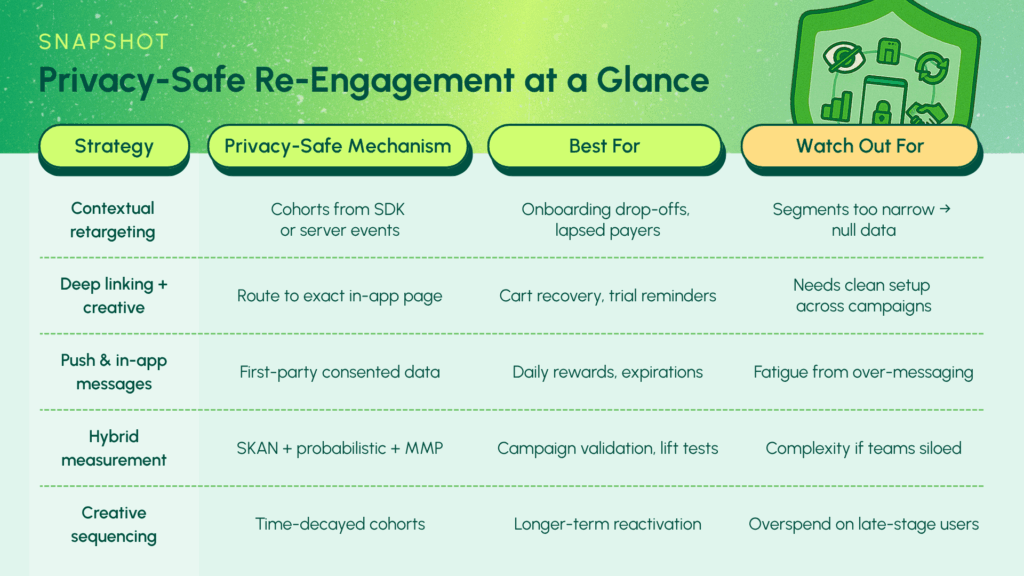
Apple’s SKAdNetwork 4 and the rise of AdAttributionKit rewrote the rules for iOS growth. Old-school IDFA retargeting is gone. Privacy-first is the new baseline.
Marketers keep asking:
- Can I re-engage users without IDFA?
- What counts as privacy-safe retargeting?
- How do I measure results under SKAN?
This guide breaks it down into 5 quick-win strategies that are both compliant and effective.

1. Contextual Retargeting Based on In-App Signals
Q: How can I retarget without IDFA?
You target contexts, not individuals. That means segmenting users into broad cohorts based on behaviors observed inside your app or through SDK-direct supply.
How it works:
- Build segments like “installed but never opened tutorial,” “completed tutorial but no purchase,” or “added item to cart but did not check out.”
- Use these groups to inform campaign messaging, without relying on persistent identifiers.
Example: A gaming app sees a large segment of users who play three sessions but do not reach level 5. That group becomes a privacy-safe cohort for ads showing “Unlock new powers at level 5.”
Why it matters:
AppsFlyer reported in 2024 that contextual signals remain predictive of monetization, especially when mapped into SKAN conversion schemas.1
Pro tip: Keep segments broad enough to cross Apple’s privacy thresholds. If too few users qualify, you will get suppressed or “null” data.
2. Deep Linking With Personalized Creative
Q: Can I bring users back without tracking who they are?
Yes. Deep linking aligns your creative message with the destination inside your app without identity tracking.
How it works:
- Create ads tailored to a context, such as abandoned cart or trial expiration.
- Use deep links to land users exactly where the creative promises.
Example: A subscription video app runs ads that say “Finish the series you started.” Clicking the ad takes users directly back to the show page in-app, not the generic home screen.
Why it matters:
Branch highlighted in 2024 that deep linking can increase reactivation rates by 2–3x compared to sending users to a default landing screen2.
Pitfall to avoid: Broken or inconsistent deep link setups frustrate users and waste ad spend. Always QA your links across iOS versions and devices.
3. Push and In-App Messaging at the Right Time
Q: Is push still a privacy-safe re-engagement channel?
Yes, if users have opted in. Push and in-app messages are based on first-party, consented data, making them one of the most compliant retention levers.
How it works:
- Use aggregated triggers like “has not opened in 7 days,” “daily reward available,” or “trial ending tomorrow.”
- Segment messaging to match user value, such as dormant payers versus free users.
Example: A fintech app sees a cohort of users who opened an account but have not deposited. A push notification says: “Start earning interest today, your account is waiting.”
Why it matters:
Adjust found in 2024 that push notifications can lift 30-day retention by 20–40% when aligned with user behavior3.
Pro tip: Use frequency caps. Over-messaging leads to opt-outs, reducing your future re-engagement options.
4. Hybrid Measurement to Track Re-Engagement
Q: How do I measure re-engagement when SKAN only provides aggregated data?
You layer methods into a hybrid measurement stack.
How it works:
- SKAN postbacks give you clean, compliant attribution.
- Probabilistic models (within privacy limits) provide fast directional reads.
- MMP dashboards reconcile both, offering a unified source of truth.
Example: A shopping app runs a SKAN-based re-engagement campaign. SKAN shows aggregated conversions, while modeled probabilistic data estimates time-to-reopen. Together, the MMP dashboard provides validated lift.
Why it matters:
Many DSPs have emphasized that hybrid measurement is now the industry baseline for both UA and re-engagement⁴. Without it, you are either flying blind or moving too slowly4.
Pitfall to avoid: Siloed reporting. If your UA and re-engagement teams track different “truths,” optimizations will conflict. Align around one reconciled dataset.
5. Creative Sequencing and Time-Decay Suppression
Q: How do I avoid spamming or overspending on lapsed users?
By combining creative sequencing with time decay.
How it works:
- Early stage: gentle nudges like “We miss you.”
- Mid stage: reminders of specific value like “Daily rewards waiting.”
- Late stage: incentives such as discounts or exclusive offers.
- Suppress users after a point to avoid waste.
Example: A lifestyle app sees many users churn after 10 days. Campaigns target them with reminders in week 2, then shift to limited-time bonuses in week 3. By week 5, the cohort is suppressed if inactive.
Why it matters:
AppsFlyer and Adjust both note that creative fatigue and overspending are leading risks in iOS re-engagement¹ ³. Smart sequencing keeps performance high and costs predictable.
Pro tip: Always align sequencing with your LTV curve. If users rarely return after 30 days, suppression should trigger well before then.
Final Checklist
- Context over identity: build cohorts from in-app signals.
- Deep links plus creative: make ads match destinations.
- Push and in-app: respect opt-ins, time them right.
- Hybrid measurement: reconcile SKAN, probabilistic, and MMP views.
- Sequencing plus suppression: stretch spend, avoid fatigue.
The Bottom Line
Privacy is not the enemy of re-engagement. It is the framework you now play in. The strongest marketers are not waiting for IDFA to make a comeback. They are building re-engagement strategies that thrive under SKAN 4 today and will be ready for AdAttributionKit tomorrow5.
👉 Ready to design a privacy-safe re-engagement strategy? Book a free iOS growth strategy session here.